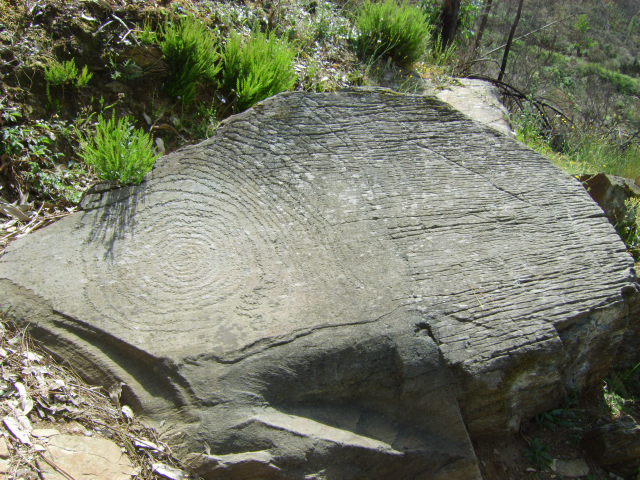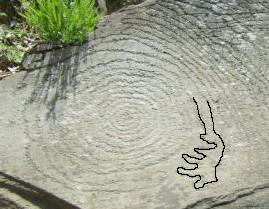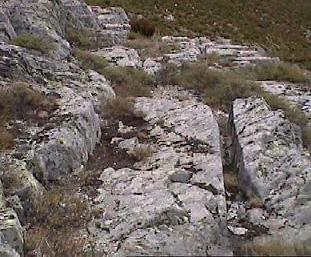|
Location:
Chaz
D'egua, Signposted from Arganil. |
Grid Reference:
40.233˚ N, 7.816˚ W. |

 Piod�o
:
(Cart-ruts, Rock-art).
Piod�o
:
(Cart-ruts, Rock-art).
The schist village of Piod�o has long been a
popular place for Portuguese to visit.
The discovery of numerous nearby examples of bronze-age
rock-art,
cart-ruts,
and several
spirals,
(of which the photo on the right is the largest),
has greatly re-enforced the value of visiting the area.
(Map of
the area - how to get there)
|
Piod�o:
('Vale d'Egua', Valley of the Mare') |
The Spiral
- This giant example of
spiral-art was recently discovered near Piod�o. The
discovery of numerous other examples of rock-art, or 'Arte
rupestre', in the same area (including several other spirals), elevates
the potential significance of this location on the megalithic landscape.
This spiral is carved on a
stone
over a metre long, which appears to be still attached to the bedrock. The
top surface looks as though it may have been 'worked' into its
parabolic form, although it is equally likely that it is a natural formation,
and might even be the reason for selecting this stone. It looks as though the
design on top is still complete, having been carved onto the rock in the
same shape we see it today.
There are two or three cup-marks on the rock and on the rock next to it,
which looks as though the front half of it has collapsed on the ground in
front of it. One wonders whether there might be other carvings on the face
down part of the rock.

The design on the stone
consists of a spiral which continues to become an 'animal' figure (which has
been suggested as being a horse), then continues to zig-zag up and down the
rock several times, before forming another shape (as yet unidentified), then
zig-zags up and down again several more times before ending (or possibly starting) at the top of the rock in a
distinct cup-mark.
 
The 'Horse'
- This feature has been suggested as being a horse, in
relation to the name of the site which is the 'Vale d'eguas', or 'valley of the
mares'.
 The
'Footprint'. The
'Footprint'.
On the rear of the stone is a 'foot-print' shaped
motif (See right), a symbol which is found on several other stones in the region.
The same area has produced over 50
examples of rock-art, seemingly scattered around on the rocks, however, their abundance in such
an isolated location , as well as the proximity of many of the
carvings to the cart-ruts, known locally as 'strada's real', or
'royal roads', make it likely that the area had some significance in the
past. The presence of carved 'feet' and carved crosses, is suggestive of a
ceremony.
The association between these two symbols has
been noticed before by Paturi
(1), who suggested that the carved 'feet'
are evidence of marriage ceremonies, and that the crosses signified the
later 'Christianisation' of such areas.
 Extract
from Paturi (1)
: 'On the
Hexenstein the witches stone near Terenten... which was most certainly
also a fertility rock, our Bronze age ancestors did not carve just cup forms
onto the rock. It is also possible to distinguish quite clearly the imprint
foot chiselled into the stone.
In places this symbol on the rock carvings is relatively frequent'. Paturi
continues 'Various scholars of prehistory have given different
interpretations of the foot imprints'. He then quotes Karl Lukan, who
maintained that the footprints are those of brides and were chiselled at the
marriage ceremony. 'They were in fact marriage documents made of stone'. Extract
from Paturi (1)
: 'On the
Hexenstein the witches stone near Terenten... which was most certainly
also a fertility rock, our Bronze age ancestors did not carve just cup forms
onto the rock. It is also possible to distinguish quite clearly the imprint
foot chiselled into the stone.
In places this symbol on the rock carvings is relatively frequent'. Paturi
continues 'Various scholars of prehistory have given different
interpretations of the foot imprints'. He then quotes Karl Lukan, who
maintained that the footprints are those of brides and were chiselled at the
marriage ceremony. 'They were in fact marriage documents made of stone'.
Interestingly, Paturi then
says 'these rites were often preserved for centuries, which was a thorn in
the flesh of the Christian church...The church endeavoured, often
unsuccessfully, to wean its lambs from the worship of pagan deities...They
decided to combat ancient magic with newly invented magic using the sign of
the cross to banish witches and evil spirits'.
The cross in the photo
(above, left), was also found carved into a rock at Piodao.
|
The
Piodao Cart -ruts - 'Strada's
Real'.
As Well as
the numerous examples
of rock-art, Piodao also has a good example of
cart-ruts or 'Strada's
real', running
along the hill-tops close by. Unlike the
Maltese cart-ruts
however, these are traditionally associated with pilgrimage.


These ruts were apparently used until relatively recently, however, their
antiquity is indicated by the many examples of prehistoric rock art or 'arte rupeste'
found alongside the ruts.
(More about the 'Portuguese cart-ruts')
|
(Cart-Ruts
Homepage)
(List of Prehistoric Portuguese sites)
(Portugal Homepage)
|